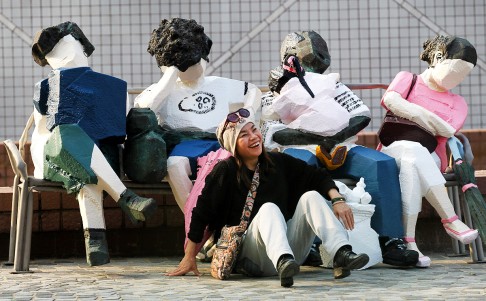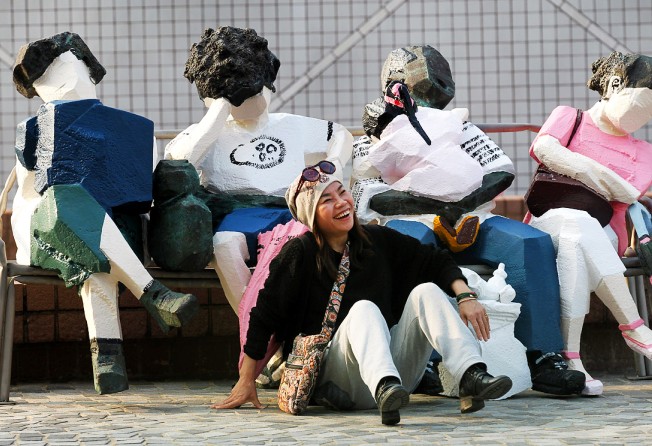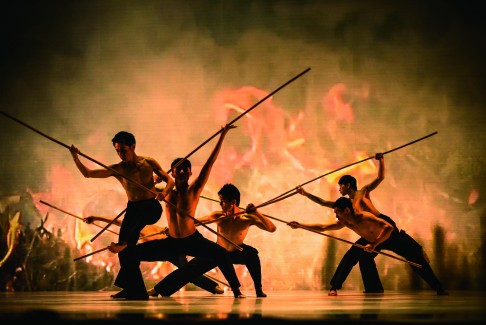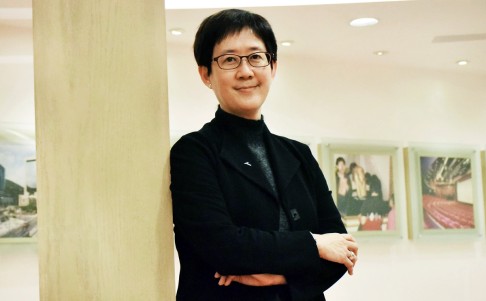
Art attack: how Hong Kong's cultural providers will cope with budget cuts
How will performing arts and museums fare under budget cuts? Two senior officials discuss the challenges ahead in the third in a series on influential figures in Hong Kong's cultural scene

With billions of dollars being spent on new cultural facilities, you would think the government could afford to fix the stage rigging system at Kwai Tsing Theatre or replace a decrepit piano at the Cultural Centre post-haste. Apparently not. Financial Secretary John Tsang Chun-wah's pessimistic outlook on government finances has ushered in an era of austerity that is deeply felt at the Leisure and Cultural Services Department, which runs 80 per cent of the city's performance arts venues and nearly all its museums.
Before the public gets to see the West Kowloon Cultural District or the new East Kowloon Cultural Centre, they may have to put up with subpar standards at existing facilities.
The irony is not lost on Elaine Yeung Chi-lan, the LCSD assistant director in charge of the performing arts division.
"We feel schizophrenic when the government talks about creating an international art hub," she says.
Yeung and fellow assistant director Chan Shing-wai are among the many civil servants who have spent their careers shaping our cultural experiences. They are important cogs in the largely nameless, faceless machinery and their anonymity obscures both their considerable power - and their challenges.
The rigidity of public services inevitably brings trials and tribulations, but there is a sense of crisis at the LCSD's Sha Tin headquarters - created in 2000 when the government dissolved the Urban Council and the Regional Council - as the department suffers a double whammy of tighter operational budgets and filibustering by lawmakers, which has put major projects on ice.
In his 2015 budget speech, Tsang outlined a plan to reduce the government's operating expenditures by 2 per cent over the next three years. The entire LCSD's operational budget received a seemingly generous 6.4 per cent year-on-year increase, but most of the extra money goes to sports, recreation, horticultural and library services.
Chan's heritage and museums division is getting just 1.6 per cent more to spend in the coming financial year when an expected 3.5 per cent inflation is accounted for.
Meanwhile, Yeung's performing arts division will, in effect, suffer a 3 per cent cut.
The government is not exactly winding back its investment in arts and culture, however. West Kowloon, run independently from the LCSD, will cost HK$47 billion. The East Kowloon Cultural Centre - a new facility with as many seats as the Cultural Centre at Tsim Sha Tsui - will take HK$4 billion to build. The price tag for the Museum of Art's much delayed renovation is HK$930 million.
But it is difficult for the public to find solace in projects that will take many more years to finish. The LCSD hopes to finally get the Museum of Art budget approved by the Legislative Council's public works subcommittee and finance committee this year, after it lost its hearing date last summer.
Museum staff have nearly finished packing up for a major overhaul that was first requested in 2011. Since last summer, the price tag has gone up 5 per cent because of rising construction costs and a 2018 reopening date may well be too optimistic.
"I am still confident we will get it through Legco because the budget isn't that big, considering we are adding 42 per cent more floor space," says Chan.
Previously in charge of conservation, Chan inherited a long to-do list when he was promoted this year, including the refurbishment of other major museums to boost visitor numbers. He estimates between six and seven million people visited the LCSD's 14 museums last year, a figure which compares favourably to visitor numbers at, say, Singaporean museums, although it is still some ways off from the traffic at top-tier establishments around the world.
Museum visitors crave more local content, Chan says.
"Interest in Hong Kong heritage has increased a lot in recent years among both local and foreign visitors, who make up 30 per cent of museum traffic."
This is supported by the footfall for recent shows such as the Heritage Museum exhibition on fashion designer Eddie Lau Pui-kei, which attracted more than 300,000 visitors over a six-month run.
The museums have also been collaborating with major institutions on the mainland and overseas, including the Andy Warhol Museum for the Andy Warhol: 15 Minutes Eternal exhibition at the Museum of Art and the Dunhuang Academy for the recent Dunhuang exhibition at the Heritage Museum.
Chan enthuses about the Louis Cha gallery that will be installed in the Heritage Museum. It will house a permanent collection paying homage to the local writer of wuxia (martial art) novels whose works have had a profound influence on Hong Kong popular culture, he says. The Science Museum and the Museum of Coastal Defence are also due for a partial makeover.
These will all present their challenges - Cha has yet to donate any of his own archives to the gallery dedicated to him, for example - but changing the Museum of History's "Hong Kong Story" permanent exhibition will likely be controversial. After all, this amounts to a retelling of the city's official history just when the issue of Hong Kong identity is particularly divisive. Could government sensitivity to foreign influence and the city's sense of exceptionalism influence the presentation of our colonial past and unique culture?
Chan appears shocked by the suggestion.
"There has been no political interference. History is based on evidence and facts. We don't look at issues based on whether they are controversial or not. We look for an interpretation that must stand the test of time," he says.
This means nothing contemporary, such as last year's Occupy Central protests, are likely to be included.
We feel schizophrenic when the government talks about creating an international arts hub [while cutting budget]
"A lot of history museums struggle to decide where they stop. Some museums refuse to include anything less than 50 years old. I don't think there should be a rigid rule but with 'Occupy', the long-term story line is unformed," he says.
The museum is still working with independent scholars and researchers before deciding on a "central axis" of Hong Kong's story, but he says there will likely be two inoffensive changes: a smaller natural history segment and the inclusion of archaeological finds that have been unearthed since 1996, back when the exhibition was first put together.
There is a less glamorous concern for Yeung, who has a strong reputation for expanding the LCSD's own cultural offerings.
(The department's World Cultures Festival and New Vision Arts Festival, which run in alternate years, rival the Hong Kong Arts Festival both for the quality of programmes commissioned and brought to town. The Chinese Opera Festival, started in 2010, is one of its most successful initiatives in recent years, showcasing regional troupes or operatic genres that are seldom seen outside the mainland.)
The real-term fall in Yeung's budget means more than just a delay in fixing the stage rigging system at Kwai Tsing Theatre, which she says is so antiquated some parts have become obsolete, or in the purchase of a new piano for the Cultural Centre's practice rooms.
Starting this year, the performing arts unit will cut funding for a category of performances called cultural presentations. Major groups, such as the Hong Kong Philharmonic Orchestra and the Hong Kong Ballet, have a variety of funding sources and the right to use LCSD venues under a venue partnership scheme. Government support for smaller groups is different: they may apply to get a free venue, free ticketing service and money to put on a show without having to fret about revenue. That is set to change.

"The current model has been running for years and we think some of the groups we've been supporting are mature enough to stand on their own two feet. Previously, the government has taken the profits and losses, even when a show sells just 30 per cent of the seats. Now, we will give them a bit less cash but they will take all the box office earnings, or losses. That's the incentive for trying to retain their supporters," she says.
This "sponsorship with a fee" model is prompted by the financial secretary's belt-tightening, but Yeung says it is healthy to wean local groups off too much government support.
Danny Yung Ning-tsun, co-artistic director of Zuni Icosahedron, is concerned this leaves little room for avant-garde shows that do not appeal to mainstream tastes. "Art needs to be ahead of what society wants and if a show can only fill 30 per cent of the hall because it brings new ideas, that should be acceptable," he says.
Yeung says the department will continue to fully fund performances that it deems worthy.
Money is enough of a headache for Yeung, but it is not her main concern. "I worry about our inability to attract young blood. Working for the government just isn't considered cool," she says.
Not cool, or plain frustrating? Yeung admits it can take ages to get the smallest changes approved and it is still difficult for managers to do anything about incompetent staff.
But she likes to remind colleagues that the cost-cutting should force them to become more efficient.
"I tell them to keep their spirits up," Yeung says. "After all, we have stable jobs and decent salaries, and we shouldn't be surprised by the public scrutiny because it's their money we spend."
